How to Analyze Stock Market Trends for Better Investments

In the dynamic world of investing, understanding stock market trends can be the difference between striking gold and striking out. Imagine navigating a bustling city without a map; you'd likely get lost or miss out on the best spots. Similarly, investing without analyzing stock trends can lead to missed opportunities or costly mistakes. So, how do you become a savvy trend analyst? Let's dive in and explore the art of stock trend analysis for better investments.
Understanding Stock Trends: The Basics
Before we delve into the intricacies of stock trend analysis, let's grasp the basics. Stock trends are the general direction in which a stock's price is moving. They can be upward (bullish), downward (bearish), or sideways (ranging). Identifying these trends helps you make informed decisions about when to buy, sell, or hold.
What Drives Stock Trends?
Stock trends are influenced by a myriad of factors, including economic indicators, company performance, industry trends, and even geopolitical events. Understanding these drivers is crucial for effective market analysis. For instance, a strong economy can boost stock prices, while political instability can send them tumbling.
Tools for Stock Trend Analysis
Analyzing stock trends requires the right tools. Here are some essential ones:
Technical Indicators
Technical indicators use historical price and volume data to predict future trends. Popular indicators include moving averages, Relative Strength Index (RSI), and Bollinger Bands. These tools help you identify patterns and make data-driven decisions.
Fundamental Analysis
Fundamental analysis involves evaluating a company's financial health and market position. This includes analyzing financial statements, earnings reports, and industry trends. Strong fundamentals often indicate a positive stock trend.
Chart Patterns
Chart patterns are visual representations of price movements. Recognizing patterns like head and shoulders, double tops, and triangles can help you anticipate trend reversals or continuations.
Investment Strategies Based on Stock Trends
Now that you have the tools, let's explore some investment strategies based on stock trends:
Trend Following
Trend following is a straightforward strategy where you buy stocks in an uptrend and sell those in a downtrend. This approach capitalizes on the momentum of the market, aiming to ride the wave of a trend until it reverses.
Mean Reversion
Mean reversion assumes that stock prices will eventually revert to their average price. This strategy involves buying stocks that are significantly below their average price and selling those that are significantly above.
Range Trading
Range trading is suitable for stocks that move within a specific price range. The idea is to buy at the lower end of the range and sell at the upper end, profiting from the price fluctuations within the range.
Stock Market Tips for Better Investments
Here are some practical stock market tips to enhance your investment techniques:
Stay Informed
Knowledge is power in the stock market. Stay updated on economic news, company announcements, and industry trends. Websites like Bloomberg and Investopedia are excellent resources.
Diversify Your Portfolio
Don't put all your eggs in one basket. Diversifying your portfolio across different sectors and companies can mitigate risk and maximize returns.
Set Clear Goals
Define your investment goals and risk tolerance. Are you aiming for long-term growth or short-term gains? Knowing your objectives will guide your investment decisions.

Advanced Techniques for Stock Trend Analysis
For those looking to take their stock trend analysis to the next level, here are some advanced techniques:
Candlestick Patterns
Candlestick patterns provide a detailed view of price movements over a specific period. Patterns like doji, hammer, and engulfing can signal trend reversals or continuations.
Volume Analysis
Volume analysis involves studying the number of shares traded over a period. High volume can indicate strong interest in a stock, while low volume may suggest a lack of interest.
Moving Averages
Moving averages smooth out price data to identify trends. Short-term moving averages (e.g., 50-day) can indicate short-term trends, while long-term moving averages (e.g., 200-day) can indicate long-term trends.
Conclusion
Analyzing stock market trends is akin to navigating a complex maze. With the right tools, strategies, and tips, you can find your way to better investments. Stay informed, diversify your portfolio, and set clear goals. Whether you're a seasoned investor or a novice, understanding stock trends can significantly enhance your investment techniques.
So, are you ready to dive into the world of stock trend analysis? The market awaits, and with the right approach, you can turn trends into profits.

FAQs
What is the best time frame for analyzing stock trends?
- The best time frame depends on your investment goals. Short-term investors may focus on daily or weekly trends, while long-term investors might look at monthly or yearly trends.
How do economic indicators affect stock trends?
- Economic indicators like GDP growth, inflation rates, and unemployment figures can significantly impact stock trends. Positive indicators often boost stock prices, while negative indicators can lead to declines.
What are some common mistakes in stock trend analysis?
- Common mistakes include relying too heavily on a single indicator, ignoring fundamental analysis, and failing to stay updated on market news.
Can stock trend analysis guarantee profits?
- While stock trend analysis can improve your chances of making profitable investments, it does not guarantee profits. The stock market is inherently unpredictable, and even the best analysis can be wrong.
How can I improve my skills in stock trend analysis?
- Improving your skills involves continuous learning and practice. Read books, attend seminars, and use online resources to stay updated on the latest trends and techniques.
Belum ada Komentar untuk "How to Analyze Stock Market Trends for Better Investments"
Posting Komentar